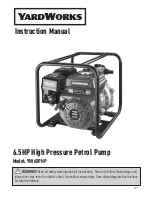
Page 11
HPXA16 SERIES
IMPORTANT
Service valves are closed to the outdoor unit and
open to line set connections. Do not open until re-
frigerant lines have been leak tested and evacuated.
All precautions should be exercised in keeping the
system free from dirt, moisture and air.
To Access Schrader Port:
1. Remove service port cap with an adjustable wrench.
2. Connect gauge to the service port.
3. When testing is completed, replace service port cap. Re-
place the stem cap. Tighten finger tight; then torque per
table 1 (Page 2).
To Open Front-Seated Service Valves:
1. Remove stem cap with an adjustable wrench.
2. Use a service wrench with a hex−head extension
(3/16" for liquid-line valve sizes; 5/16" for vapor-line
valve sizes) to back the stem out counterclockwise as
far as it will go.
3. Replace the stem cap. Tighten finger tight; then torque
per table 1 (Page 2).
To Close Front-Seated Service Valves:
1. Remove the stem cap with an adjustable wrench.
2. Use a service wrench with a hex−head extension
(3/16" for liquid-line valve sizes; 5/16" for vapor-line
valve sizes) to turn the stem clockwise to seat the
valve. Tighten it firmly.
3. Replace the stem cap. Tighten finger tight; then torque
per table 1 (Page 2).
Ball-Type Service Valve (Vapor Line)
Ball-type service valves function the same way as the oth-
er valves; the difference is in the construction. These
valves are not rebuildable. If a valve has failed, you must
replace it. A ball valve is illustrated in figure 16.
The ball valve is equipped with a service port with a factory−
installed Schrader valve. A service port cap protects the
Schrader valve from contamination and assures a leak−
free seal.
Leak Testing
After the line set has been connected to the indoor and out-
door units, the line set connections and indoor unit must be
checked for leaks.
WARNING
Refrigerant can be harmful if it is inhaled. Refriger-
ant must be used and recovered responsibly.
Failure to follow this warning may result in personal
injury or death.
WARNING
Fire, Explosion and Personal Safety
Hazard.
Failure to follow this warning could
result in damage, personal injury or
death.
Never use oxygen to pressurize or
purge refrigeration lines. Oxygen,
when exposed to a spark or open
flame, can cause damage by fire and/
or an explosion, that could result in
personal injury or death.
WARNING
When using a high pressure gas such
as dry nitrogen to pressurize a refrig-
eration or air conditioning system,
use a regulator that can control the
pressure down to 1 or 2 psig (6.9 to
13.8 kPa).
Using an Electronic Leak Detector
1. Connect a cylinder of HFC−410A to the center port of
the manifold gauge set.
2. With both manifold valves closed, open the valve on
the HFC−410A cylinder (vapor only).
3. Open the high pressure side of the manifold to allow
the HFC−410A into the line set and indoor unit. Weigh
in a trace amount of HFC−410A .
[A trace amount is a
maximum of 2 ounces (57 g) or 3 pounds (31 kPa)
pressure.]
Close the valve on the HFC−410A cylinder
and the valve on the high pressure side of the manifold
gauge set. Disconnect the HFC−410A cylinder.
4. Connect a cylinder of dry nitrogen with a pressure reg-
ulating valve to the center port of the manifold gauge
set.
5. Connect the manifold gauge set high pressure hose to
the vapor valve service port.
(Normally, the high pres-
sure hose is connected to the liquid line port; however,
connecting it to the vapor port better protects the man-
ifold gauge set from high pressure damage.)
6. Adjust the dry nitrogen pressure to 150 psig (1034
kPa). Open the valve on the high side of the manifold
gauge set which will pressurize line set and indoor unit.
7. After a few minutes, open a refrigerant port to ensure
the refrigerant you added is adequate to be detected.
(Amounts of refrigerant will vary with line lengths.)
Check all joints for leaks. Purge dry nitrogen and
HFC−410A mixture. Correct any leaks and recheck.
IMPORTANT
Leak detector must be capable of sensing HFC re-
frigerant.










































